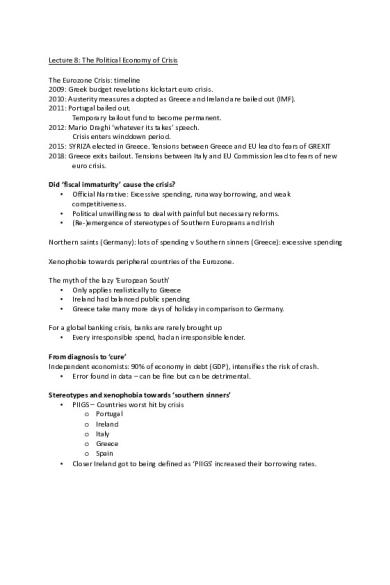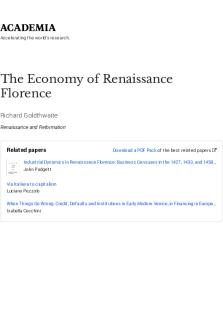The Political Economy of Crisis PDF

| Title | The Political Economy of Crisis |
|---|---|
| Course | European Politics |
| Institution | University of Sussex |
| Pages | 5 |
| File Size | 220.5 KB |
| File Type | |
| Total Downloads | 85 |
| Total Views | 167 |
Summary
Lecture notes on European Politics module...
Description
Lecture 8: The Political Economy of Crisis The Eurozone Crisis: timeline 2009: Greek budget revelations kickstart euro crisis. 2010: Austerity measures adopted as Greece and Ireland are bailed out (IMF). 2011: Portugal bailed out. Temporary bailout fund to become permanent. 2012: Mario Draghi ‘whatever its takes’ speech. Crisis enters winddown period. 2015: SYRIZA elected in Greece. Tensions between Greece and EU lead to fears of GREXIT 2018: Greece exits bailout. Tensions between Italy and EU Commission lead to fears of new euro crisis. Did ‘fiscal immaturity’ cause the crisis? • Official Narrative: Excessive spending, runaway borrowing, and weak competitiveness. • Political unwillingness to deal with painful but necessary reforms. • (Re-)emergence of stereotypes of Southern Europeans and Irish Northern saints (Germany): lots of spending v Southern sinners (Greece): excessive spending Xenophobia towards peripheral countries of the Eurozone. The myth of the lazy ‘European South’ • Only applies realistically to Greece • Ireland had balanced public spending • Greece take many more days of holiday in comparison to Germany. For a global banking crisis, banks are rarely brought up • Every irresponsible spend, had an irresponsible lender. From diagnosis to ‘cure’ Independent economists: 90% of economy in debt (GDP), intensifies the risk of crash. • Error found in data – can be fine but can be detrimental. Stereotypes and xenophobia towards ‘southern sinners’ • PIIGS – Countries worst hit by crisis o Portugal o Ireland o Italy o Greece o Spain • Closer Ireland got to being defined as ‘PIIGS’ increased their borrowing rates.
What actually caused the Eurozone crisis? Different approaches • Official narrative (Hans Werner-Sinn, European Commission, Governments of European Periphery) • Design Flaws (Paul de Grauwe) • Varieties of Capitalism (Peter Hall, Alison Johnston) • Core-Periphery Analysis (Costas Lapavitsas, Andrew Moravscik) • Financialisation (Erik Jones) • Divergence via Europeanisation (Neil Dooley)
Headline claims • ‘PIIGS’ didn’t follow the rules, they caused the crisis. • The Euro was designed poorly, crisis was always only a matter of time • Economic and Monetary Union was applied across a range of incompatible varieties of capitalism. • German export success reliant on peripheral import dependency and indebtedness • Growing power of unchecked finance to blame • Periphery followed the rules of EU financial integration, which dangerously transformed economies into debt-led models of growth.
What were the political effects of austerity? • Austerity policies impacted all European states, but European periphery impacted more than others. • Drop in trust and support for mainstream parties? • Rise in support for populists on right and left? What impact did austerity have on the European Periphery?
Rising unemployment
Declining economic growth
Rising emigration
Austerity and Greek Politics Five elections, rise in Euroscepticism •
Electoral instability • Five elections between 2009-2019 • Public opposition to austerity pivotal
•
Wholesale rejection of mainstream parties (PASOK and ND)?
•
Gains for populists on the left, and to a lesser extent, on the right. • SYRIZA emerge as largest party • Far-right Golden Dawn consistently at 6-7% of vote
Referendum 2015: 60% voted to reject 3rd bailout (advisory referendum, still received the bailout and led to harshest measure of austerity Greece had to endure). Euroscepticism: Greece is now highly critical of the Eurozone but this has not translated into the position of hard scepticism (wanting to leave). • •
In spite of declining support for EU, no ‘GREXIT’ movement has emerged. • Replaced by soft sceptics 2019: A return to mainstream: Return of ND, electoral wipeout of Golden Dawn, and (some) punishment of SYRIZA.
Austerity and Irish Politics Mainstream parties punished, no rise in Euroscepticism, no growth in populist parties • Mainstream parties severely punished, especially Fianna Fáil – voters punishing party? • Labour and Fine Gael punished in 2016 – leading to minority gov led by FG, supported by FF. (Mainstream parties punished and continue to be punished) (No emergence of populist parties – but increase in votes for Sinn Féin: not dramatic) • • • • •
2019 European Elections – 33.15% of MEP candidates have ‘Eurosceptic’ platform. But only tiny proportion (2) were hard Eurosceptic. Ireland remains one of the most pro-EU countries, and has seen EU support rise after Brexit. No meaningful support for populists, some gains for small left parties and independents. Anti-austerity outside ballot box: Irish Water Protests 2019: Less than 1% voted to leave the EU
(85% of Irish respondents think EU membership is a good thing)
Austerity and Portuguese Politics No mainstream party punishment, little/no success for Europopulism or Euroscepticism. • • •
• •
Three elections since 2009: 2011, 2015, and 2019. 2011: Centre right PSD received 38.7% of the vote, PS received 28 per cent. Centre held in Portugal. 2015: PSD emerged as biggest party but couldn’t form a majority coalition this time. Surprising result was a left wing coalition led by the second biggest party. – PS PCP BE coalition – would have been unthinkable before crisis. 2019: Modest gains for PS (Centre Left). Chega (far right) got 1 MP into parliament. Surprising lack of upheaval: no Syriza or Fianna Fáil effect, little success for right wing populism, or for Euroscepticism.
Why did austerity have such different political effects? • Some similarities: relatively poor performance for far-right, no success for ‘hardEurosceptic’ parties. •
Social cleavages and national party systems: different pre-existing divisions in Greece, Portugal, Ireland. Different kinds of opposition parties available.
•
Narratives - ‘to blame is to explain’: was the crisis framed as externally imposed or home-grown? Was the crisis viewed as existential threat, was austerity framed as without alternative?
Did Austerity work? • “Greece has a role model, and that role model is Ireland” – Trichet (former ECB president). • Ireland a success story of austerity. • Unemployment down from 15% in 2012 to 5.4% in September 2018. • One of fastest growing economies in Europe – 7.8% GDP growth (1.8% in UK). • But why have other countries who introduced austerity struggled? Comparative Political Economy • Look at ‘growth models’/varieties of capitalism across Greece, Ireland and Portugal. • Ireland’s recovery has nothing to do with lower wage costs/improving public finances. • Ireland specialises in high-wage, high-tech exports. Benefits from Silicon Valley tech boom, QE from US government post-2008. • Greece lacks similar export structure, and austerity suffocates domestic demand. • Portugal: recent recovery coincides with rolling back of austerity post-2015. Export growth
Foreign Direct Investment
Conclusion 1. Debate remains on the causes of the eurozone crisis, but ‘official narrative’ of austerity and structural reform was an early winning explanation. 2. The eurozone crisis has dramatically transformed politics across Europe, but in different, sometimes puzzling ways. 3. Austerity didn’t necessarily help end the crisis, new fault lines in Italy may show limits of the policy....
Similar Free PDFs

The Political Economy of Crisis
- 5 Pages

political economy
- 9 Pages

A Political Economy Approach
- 358 Pages

Statist political economy
- 7 Pages

The Theory of Political Culture
- 278 Pages

The origins of the urban crisis
- 9 Pages
Popular Institutions
- Tinajero National High School - Annex
- Politeknik Caltex Riau
- Yokohama City University
- SGT University
- University of Al-Qadisiyah
- Divine Word College of Vigan
- Techniek College Rotterdam
- Universidade de Santiago
- Universiti Teknologi MARA Cawangan Johor Kampus Pasir Gudang
- Poltekkes Kemenkes Yogyakarta
- Baguio City National High School
- Colegio san marcos
- preparatoria uno
- Centro de Bachillerato Tecnológico Industrial y de Servicios No. 107
- Dalian Maritime University
- Quang Trung Secondary School
- Colegio Tecnológico en Informática
- Corporación Regional de Educación Superior
- Grupo CEDVA
- Dar Al Uloom University
- Centro de Estudios Preuniversitarios de la Universidad Nacional de Ingeniería
- 上智大学
- Aakash International School, Nuna Majara
- San Felipe Neri Catholic School
- Kang Chiao International School - New Taipei City
- Misamis Occidental National High School
- Institución Educativa Escuela Normal Juan Ladrilleros
- Kolehiyo ng Pantukan
- Batanes State College
- Instituto Continental
- Sekolah Menengah Kejuruan Kesehatan Kaltara (Tarakan)
- Colegio de La Inmaculada Concepcion - Cebu









